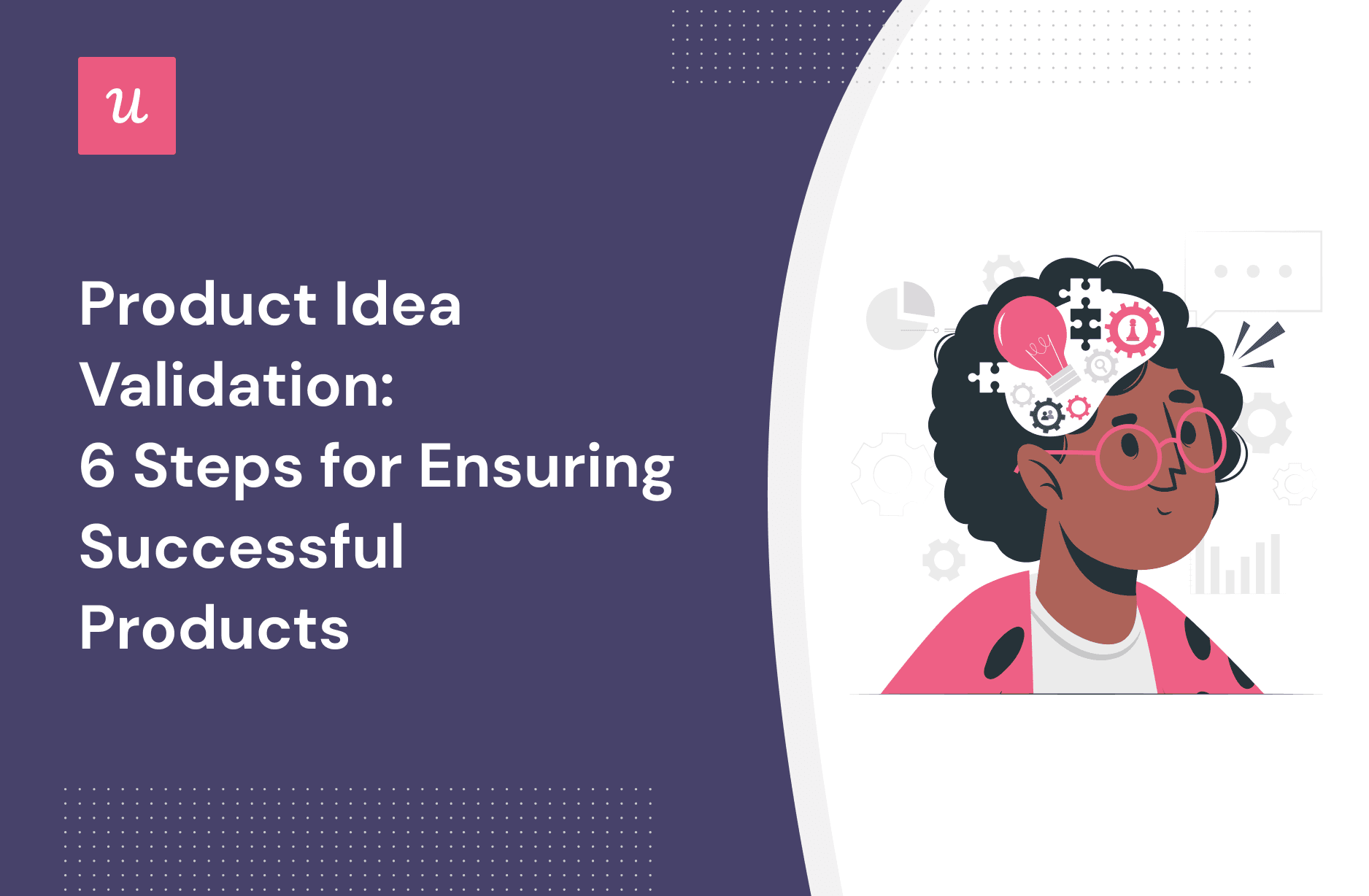
Product Idea Validation: 6 Steps for Ensuring Successful Products
Why is product idea validation important? As a product manager, how can you effectively validate ideas and build a successful product that delights users?
This is the key focus of our guide. We look at the process of idea validation and a range of tools and techniques you can leverage to aid the process.
Let’s get straight into it!
How do you currently test if there’s real demand for a new feature idea?
Try Userpilot Now
See Why 1,000+ Teams Choose Userpilot

Summary of product idea validation
- Product idea validation is a process during which product teams test and tweak the product concept to ensure it satisfies a real market need.
- Apart from testing the demand for the product, idea validation helps teams assess if they have the necessary expertise and resources to build the product.
- Product idea validation is essential to avoid spending too many resources on a product that fails because nobody needs it.
- The idea validation process consists of 6 steps.
- First, you need to clearly define the product goals, the problems it solves, and its alignment with the organization’s business goals.
- Next, it’s time for market research which focuses on industry trends, assessment of the competitive landscape, and evaluation of the financial viability of the solution.
- In step 3, you need to define your target audience and create user personas. To start with, it’s easier to cater to the needs of a small group of users.
- In Step 4, you seek customer insights and run experiments to assess user interest. Popular validation techniques include online surveys, user interviews and focus groups, and fake door tests.
- If you’re launching a brand-new product and have no user base, build a landing page and collect the contact details of prospective customers to gauge their interest.
- Offering an early bird discount could be a good way to encourage early adopters to commit to the product even when it’s not completely ready.
- A minimum viable product (MVP) is a version of the product with only core features.
- Once you launch the MVP, you can use product usage data and customer feedback to inform further iterations.
- As you’re getting ready to launch the MVP, make sure to develop a robust go-to-market strategy to drive customer acquisition and revenue generation.
- Regular PMF surveys help teams to ensure that their product is still satisfying a valid user need.
- If you want to see how Userpilot can help you validate your product ideas, book the demo!
What is product idea validation?
Product idea validation is a part of the ideation process that enables product teams to build products that satisfy a market need.
During the process, the product managers or product owners answer a few basic questions:
- Does the product solve a genuine user problem?
- Are there enough users who are ready to pay for a solution to the problem?
- Do we have enough expertise to build the solution?
- Do we have enough financial resources to realize the business idea?
- Is it the best way to invest the resources?
Why validate product ideas before building them?
In short, product idea validation is necessary to ensure that there is a market need for the product and it offers features and functionality that accurately addresses the pain points the target audience faces.
In this way, PMs avoid wasting substantial resources on product initiatives that customers don’t need and that don’t help the organization achieve its goals. In a nutshell, it saves you from product failure and having to sunset products in the future.
6 steps of the product validation process
The product validation process consists of 6 key stages. Let’s look at each of them one by one.
Step 1: Clearly define your product idea
Start by defining your product idea in as much detail as possible. Some questions to answer include:
- What is the product?
- What customer pain points, needs, or wants does it address?
- Who is the target audience?
- What are the product goals?
- What are the key product features?
- How is it aligned with your organization’s vision, strategy, and business model?
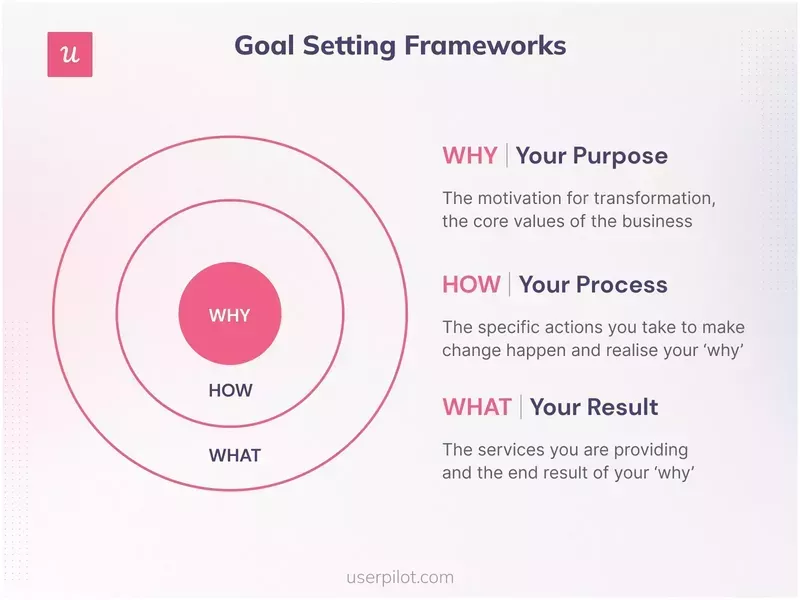
Step 2: Conduct market research to gauge market demand
Market research is a critical step in the product idea validation process.
It helps you gather valuable insights about the market, customer interests, industry trends, competitors, and the financial viability of the product.
Study industry trends
Studying industry trends will help you determine how well your product idea fits into the current market landscape and whether the world is ready for your product. It can also help you discover new opportunities.
How do you go about it?
Google Trends is a popular tool that can help you identify popular keywords and search topics. They could be an indication of what users are currently interested in.
You can also get ideas about the direction of the market from industry blogs, reports, and publications. Monitoring social media platforms and online communities can also shed light on market trends.
Analyze the competitive landscape
Analyzing the competitive landscape is essential to understand the existing solutions in the market, finding potential gaps you could fill, and identifying areas for differentiation.
Start by listing your main competitors and assessing their strengths and weaknesses. Look at how they price and market their product. You can also study customer reviews to find cracks you could exploit.
Evaluate the financial viability of your product idea
No matter how brilliant your product idea is, it won’t float if you either don’t have money to build it or the ROI doesn’t justify the investment.
Apart from looking at the costs and possible ROI, assess it also against other opportunities.
Not building the product at all is a valid option too if the cost of financing it is higher than the returns. For example, the interest rates of the loan could be too high or you might get a better return if you leave the capital in the bank.
Step 3: Identify the target market of potential customers
The market validation process will also allow you to identify your target customer groups.
If you’re building a completely new product, it’s a good idea to start with a small specific segment, like a particular age group or a professional group. That’s because satisfying the needs of a small user segment with very specific attributes is much easier than building a product for everyone.
To give you the necessary focus, develop target user personas. In their profiles, include information on:
- Their use case
- Their role in their organizations
- Who do they work with
- Their pain points
- Benefits of using the product
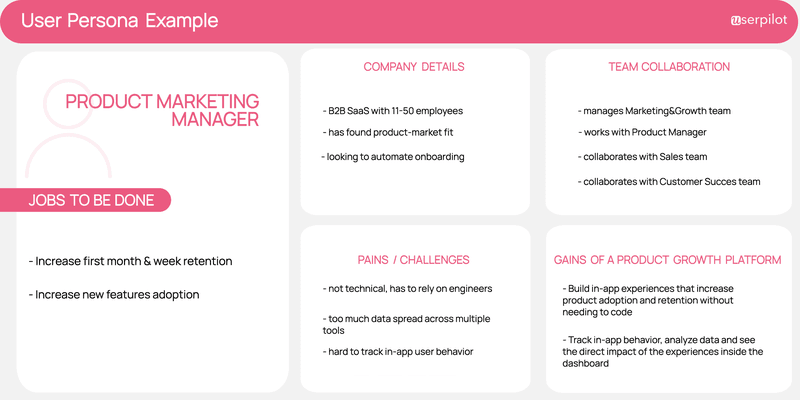
Step 4: Use different strategies to validate a product idea
When validating product ideas, there are a few tricks of the trade that product managers can leverage to inform their decisions.
Conduct online surveys and user interviews
Online surveys are an easy way to collect customer insights at scale.
There are a couple of ways to do it. You can either collect active feedback by triggering your in-app surveys for specific user segments at a specific time or collect passive feedback with a feedback widget. In addition, you can use email to deliver your surveys.
And what if you have no product or user base yet?
Lean into your social media followers and pick their brains.
Interviews and focus groups are other popular ways to collect qualitative insights. They give you additional flexibility to ask follow-up questions but are more time-consuming and logistically challenging to organize.
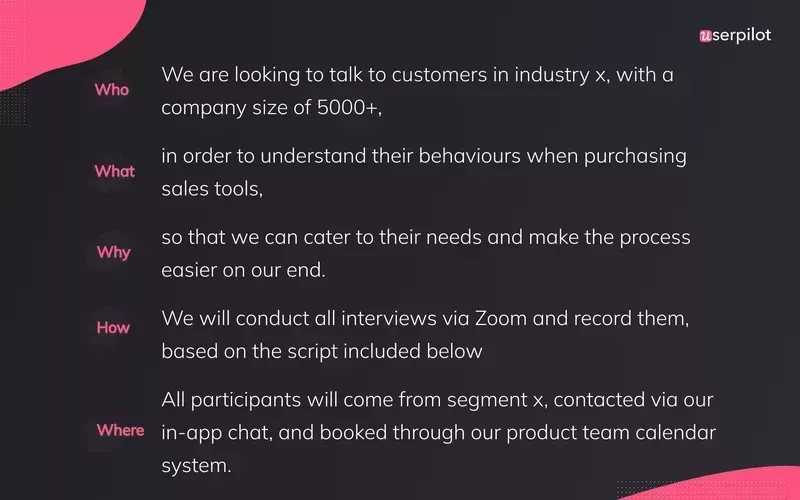
Carry out a fake door test
Fake door tests are a popular technique for validating product or feature ideas before you invest in their development.
To carry out the test, you simply add the feature to your menu or dashboard, as if it was already available. To drive traffic, create a tooltip like the one below.
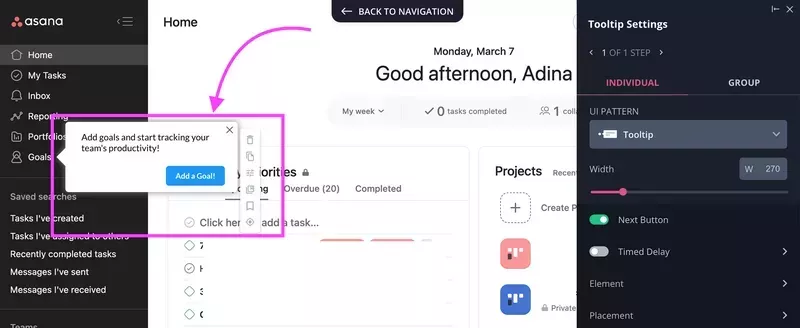
Then track user engagement. If enough users click on the feature, it’s an indication that there’s enough interest.
Of course, once they click on it, they will realize you’ve actually conned them, so make sure to explain the purpose of all the shenanigans. If the new feature looks promising, they will forgive you.
Beware though, as fake door tests could alienate your users if you run them too often.
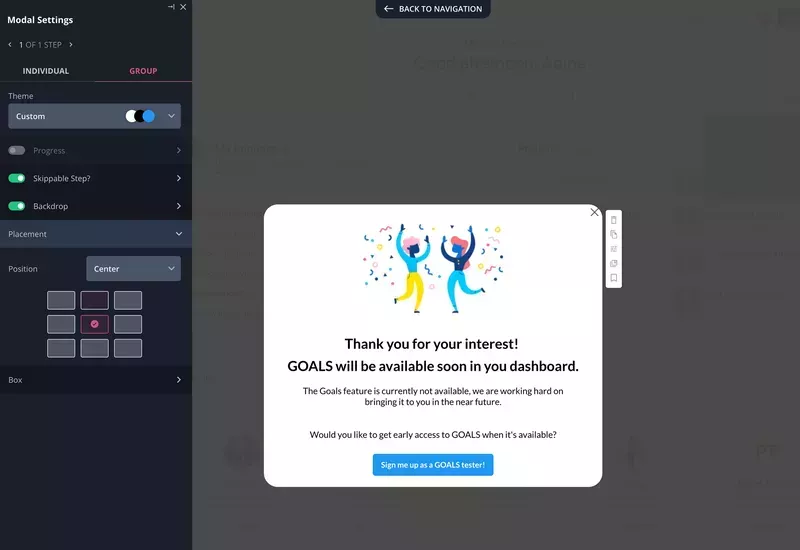
Create a landing page and collect contacts of prospective customers
What if you have no product to conduct the fake door test in?
No problem. Just create a landing page with product details and video demos, and use paid ads to drive traffic. Once users land on your page, collect their contact details.
In this way, you will be able to test the market demand. If the product idea is attractive to prospective users, they will want to hear about it when it’s ready. This is also a good way to recruit focus groups, interview participants, or beta testers for the future.
To encourage users to submit their details, why not offer them incentives like early access to the product once it’s ready to roll out?

Offer an early bird discount
As the product is not quite ready yet, people may not be ready to pay the full price for it. An early bird discount can be an incentive for innovators and early adopters to make the purchase after all.
In this way, you will be able to assess interest in the product and finance its further development. What’s even more important, you will get access to valuable usage data and feedback that is essential to inform further iterations.
Step 5: Create a minimum viable product for idea validation
The minimum viable product (MVP) is a functional but unpolished version of the product with only core features.
Why would you want to launch a product that’s not 100% ready?
The truth is it’s impossible to build a 10/10 product without testing how it performs in real life.
So instead of hiding your product behind the garage door until you think it’s ready, just launch it.
Step 6: Iterate, refine, and develop your product idea
Once it’s out, watch how users engage with the product. Track product usage data, collect their feedback in-app, and analyze their interactions with customer support and success teams.
That’s how you will be able to pick up all the bugs and identify areas for improvement. In some instances, you may discover that a more major pivot is necessary.
When acting on the insights, implement changes in small increments but often. Test the impact of the changes before introducing further ones.
In this way, you will avoid investing your time and effort in initiatives that don’t add value to the product or are based on wrong assumptions.
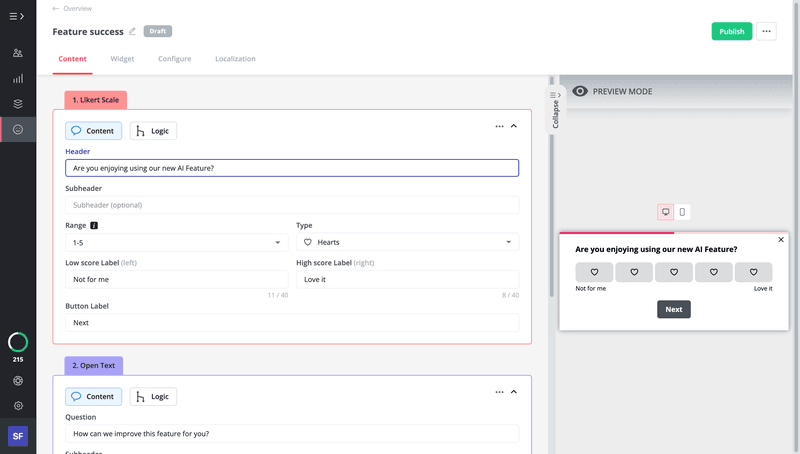
What’s next: What should product managers do after idea validation?
Validating the product idea and launching the product is just a part of the product management process. As you are iterating on the MVP, you also need to start thinking about promoting the product and assessing its readiness for the market.
Create a go-to-market strategy
A go-to-market strategy is a plan on how to introduce your product to the market and drive its adoption and success. Its main goal is to boost market penetration, customer acquisition, and revenue generation.
Common elements of a GTM strategy include:
- Product value proposition (key product benefits when compared to competitors).
- Product positioning and messaging (to communicate the value proposition in a compelling way that resonates with the target audience).
- Acquisitions model (freemium, free trial, paid trial?).
- Pricing (tiered pricing plan and how much to charge based on the competitive landscape).
- Promotion and marketing strategy (best ways to reach the target audience, like digital marketing, content marketing, or social media campaigns).
- Customer onboarding and support (to ensure your users can adopt the product without friction).
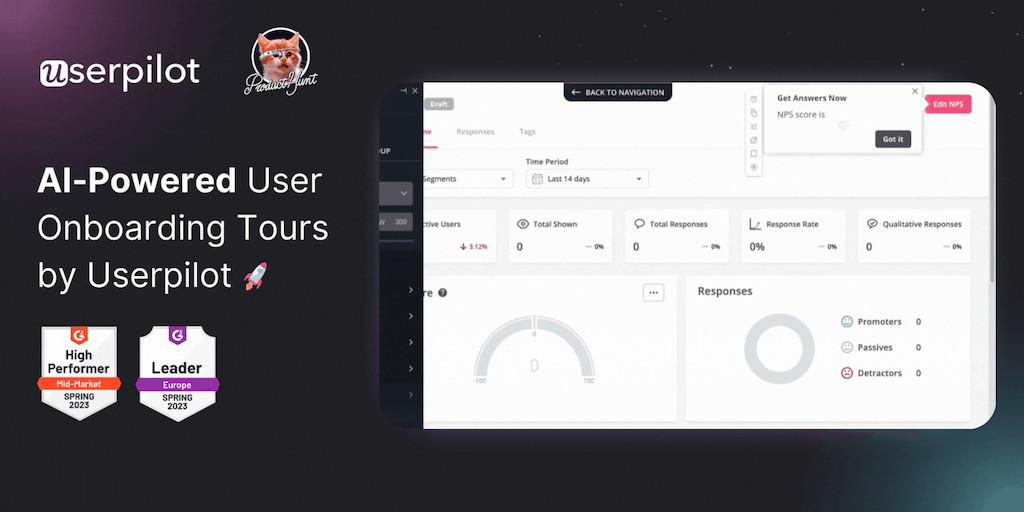
Carry out a product-market fit survey
A product has achieved product-market fit when there are enough customers that are ready to pay for it. Consequently, product-market fit surveys help teams to improve the product and refine the GTM strategy so that it better satisfies a market need.
The PMF survey, also called the Sean Ellis test, asks users how disappointed they would be if they could no longer use the product. If 40% of users respond ‘very disappointed’, it means you’ve achieved product-market fit.
Of course, achieving PMF is just the beginning. You can easily lose as a result of changes in user needs or disruptive technologies. That’s why it’s important to run the surveys regularly, say every 3-6 months, to keep a pulse on the market shifts.
Creating and launching the PMF surveys is easy if you have the right tools. For example, in Userpilot, you can use a template to create your survey and then trigger it to the right user segment. These should be customers who have used the product long enough to know its features.
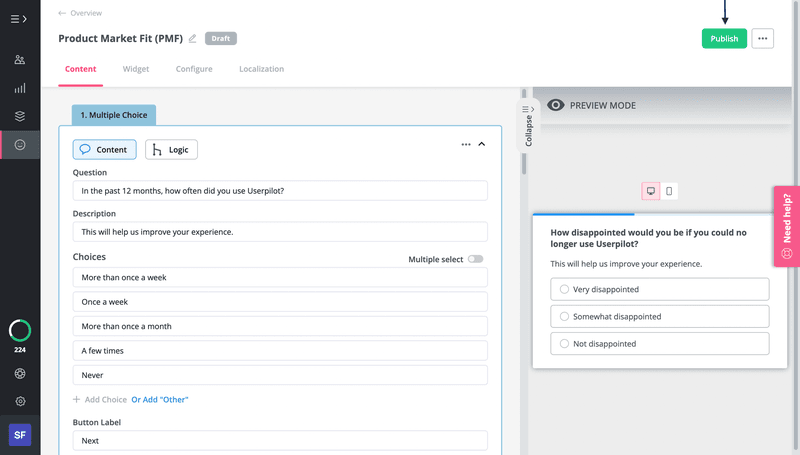
Conclusion
Product idea validation is essential if you’re serious about building a successful product. It allows you to determine if there’s enough demand for the product in the potential market.
Ideally, idea validation should be an inherent part of the development process so that you can weed out faulty ideas in their very raw stages, before any significant investment.
If you want to see how Userpilot can help you validate your product ideas, book the demo!







